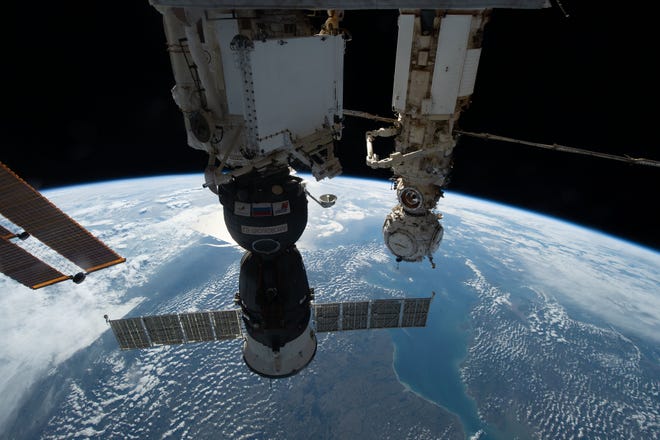BREVARD, Fla. — NASA astronaut Frank Rubio and Russian cosmonauts Sergey Prokopyev and Dmitri Petelin are faced with extending their stay aboard the International Space Station by several months and will require a new ride home after their Russian MS-22 Soyuz spacecraft sprang a leak last month.
The trio was supposed to use that spacecraft to return to Earth in March. Wednesday, NASA and Russian space officials unveiled a plan to launch an empty Soyuz capsule to the ISS to ferry them back instead. That means the three men will spend several more months at the ISS.
During a briefing with reporters, NASA’s Joel Montalbano, manager of the International Space Station program, said that NASA is not considering the move-up in the MS-23 Soyuz launch a rescue mission. “We’re not calling it a rescue Soyuz,” said Montalbano. “Right now, the crew is safe onboard the space station.”
“I’m calling it a replacement Soyuz,” he said. “There’s no immediate need for the crew to come home today.”
Extended space stay
Initially set to fly the next rotation of Russian cosmonauts to the station in mid-March, the MS-23 Soyuz spacecraft is now being repurposed to launch as an empty lifeboat to ferry the MS-22 crew home later this year. The empty spacecraft is set to launch from Baikonur Cosmodrome in Kazakhstan on Feb. 20.
Flying the MS-23 crew up as previously planned would have left the ISS in the same situation, with more people on board than available seats on functioning spacecraft to evacuate back to Earth in the unlikely event of a catastrophe.
WHAT IS PLANET TOI 700 E LIKE?:NASA just found a planet almost the size of Earth and it’s in the habitable zone of a star
That means that Rubio, Prokopyev, and Petelin will need to extend their space stay until September or until Roscosmos can build another Soyuz spacecraft to launch its next rotation of crew members, which are now stuck grounded for longer than anticipated.
According to Montalbano, the space station remains safe, and the crew members are healthy enough to remain in space while this plan plays out.
“They’re prepared to stay until the September launch date, if that’s the case,” said Montalbano. “If that launch date moves up earlier, then they’re prepared to come home earlier.”
Jokingly, he said: “I may have to find some more ice cream to reward them.”
“The awesome thing about our crews are they’re willing to help wherever we ask,” he said. “They are ready to go with whatever decision that we give them.”
A Russian space leak
The MS-22 Russian Soyuz spacecraft that transported Rubio, Prokopyev, and Petelin to the station back in September sprang a leak on Dec. 14. Coolant from an external coolant loop and radiator on the spacecraft spewed into space for hours just as Prokopyev and Petelin were preparing to conduct a spacewalk. Out of an abundance of caution to prevent any exposure to the leaking substance, the spacewalk was canceled.
On Dec. 18, NASA used the station’s robotic arm, Canadarm2, to provide images and conduct an additional external inspection of the damaged spacecraft.
After a joint investigation conducted by NASA and Roscosmos, the space agencies are confident that the damage was caused by a micrometeoroid impact that resulted in a hole of about one millimeter in diameter in the coolant loop.
While it was determined that the leak posed no immediate threat to the station or crew, it left the MS-22 Soyuz spacecraft incapable of returning the trio of astronauts home safely.
The damaged coolant loop meant that the temperature and humidity inside the cabin of the Soyuz spacecraft could skyrocket, making for a very uncomfortable and claustrophobic return trip home, typically taking about six hours to complete.

The path forward
Instead of returning crew as expected, roughly two weeks after the replacement MS-23 Soyuz docks at the station, the damaged MS-22 spacecraft will be outfitted as a cargo transport ship. NASA and Roscosmos intend to collect data about the conditions inside the cabin as the spacecraft makes its trip back for a landing in Kazakhstan in mid-to-late March.
“On the returning Soyuz, we’ll be taking some temperature measurements to measure how the vehicle does in this scenario such that if we ever had a need in the future, we have some additional data,” said Montalbano. “We’re going to fully use this vehicle all the way till it lands back on Earth.”
Also speaking to reporters on Wednesday, Sergei Krikalev, Roscosmos director of human space flight, said, “At this point, we have calculations and thermal scenarios, but we want to prove this calculation with the result (in) real-time.”
FACT CHECK:NASA says Earth is a globe, uses ‘flat and non-rotating’ model in equations
Going forward, this will most likely impact the busy schedule of crew and cargo missions to the station for the rest of this year. How it impacts specific mission launch dates, such as NASA’s next crewed mission, SpaceX’s Crew-6, which was to launch from Kennedy Space Center in mid-February, has yet to be fully determined.
“We’re going to take the next couple of weeks to kind of lay out the plan,” said Montalbano. The shift is expected to impact at least four crewed missions and two cargo resupply missions to the station through at least September.
“Laying everything out is what we’re going to plan now. We just need a couple more weeks to lay all that out,” Montalbano said.

